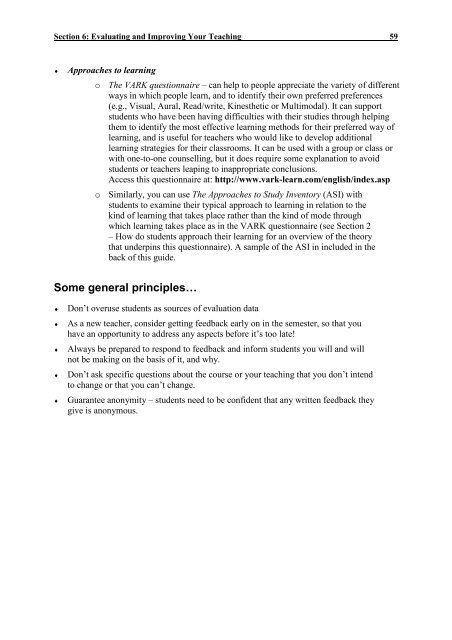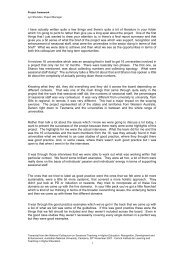A tutor's guide to teaching and learning at UQ - TEDI - University of ...
A tutor's guide to teaching and learning at UQ - TEDI - University of ...
A tutor's guide to teaching and learning at UQ - TEDI - University of ...
Create successful ePaper yourself
Turn your PDF publications into a flip-book with our unique Google optimized e-Paper software.
Section 6: Evalu<strong>at</strong>ing <strong>and</strong> Improving Your Teaching 59♦Approaches <strong>to</strong> <strong>learning</strong>o The VARK questionnaire – can help <strong>to</strong> people appreci<strong>at</strong>e the variety <strong>of</strong> differentways in which people learn, <strong>and</strong> <strong>to</strong> identify their own preferred preferences(e.g., Visual, Aural, Read/write, Kinesthetic or Multimodal). It can supportstudents who have been having difficulties with their studies through helpingthem <strong>to</strong> identify the most effective <strong>learning</strong> methods for their preferred way <strong>of</strong><strong>learning</strong>, <strong>and</strong> is useful for teachers who would like <strong>to</strong> develop additional<strong>learning</strong> str<strong>at</strong>egies for their classrooms. It can be used with a group or class orwith one-<strong>to</strong>-one counselling, but it does require some explan<strong>at</strong>ion <strong>to</strong> avoidstudents or teachers leaping <strong>to</strong> inappropri<strong>at</strong>e conclusions.Access this questionnaire <strong>at</strong>: http://www.vark-learn.com/english/index.aspo Similarly, you can use The Approaches <strong>to</strong> Study Inven<strong>to</strong>ry (ASI) withstudents <strong>to</strong> examine their typical approach <strong>to</strong> <strong>learning</strong> in rel<strong>at</strong>ion <strong>to</strong> thekind <strong>of</strong> <strong>learning</strong> th<strong>at</strong> takes place r<strong>at</strong>her than the kind <strong>of</strong> mode throughwhich <strong>learning</strong> takes place as in the VARK questionnaire (see Section 2– How do students approach their <strong>learning</strong> for an overview <strong>of</strong> the theoryth<strong>at</strong> underpins this questionnaire). A sample <strong>of</strong> the ASI in included in theback <strong>of</strong> this <strong>guide</strong>.Some general principles…♦♦♦♦♦Don’t overuse students as sources <strong>of</strong> evalu<strong>at</strong>ion d<strong>at</strong>aAs a new teacher, consider getting feedback early on in the semester, so th<strong>at</strong> youhave an opportunity <strong>to</strong> address any aspects before it’s <strong>to</strong>o l<strong>at</strong>e!Always be prepared <strong>to</strong> respond <strong>to</strong> feedback <strong>and</strong> inform students you will <strong>and</strong> willnot be making on the basis <strong>of</strong> it, <strong>and</strong> why.Don’t ask specific questions about the course or your <strong>teaching</strong> th<strong>at</strong> you don’t intend<strong>to</strong> change or th<strong>at</strong> you can’t change.Guarantee anonymity – students need <strong>to</strong> be confident th<strong>at</strong> any written feedback theygive is anonymous.



